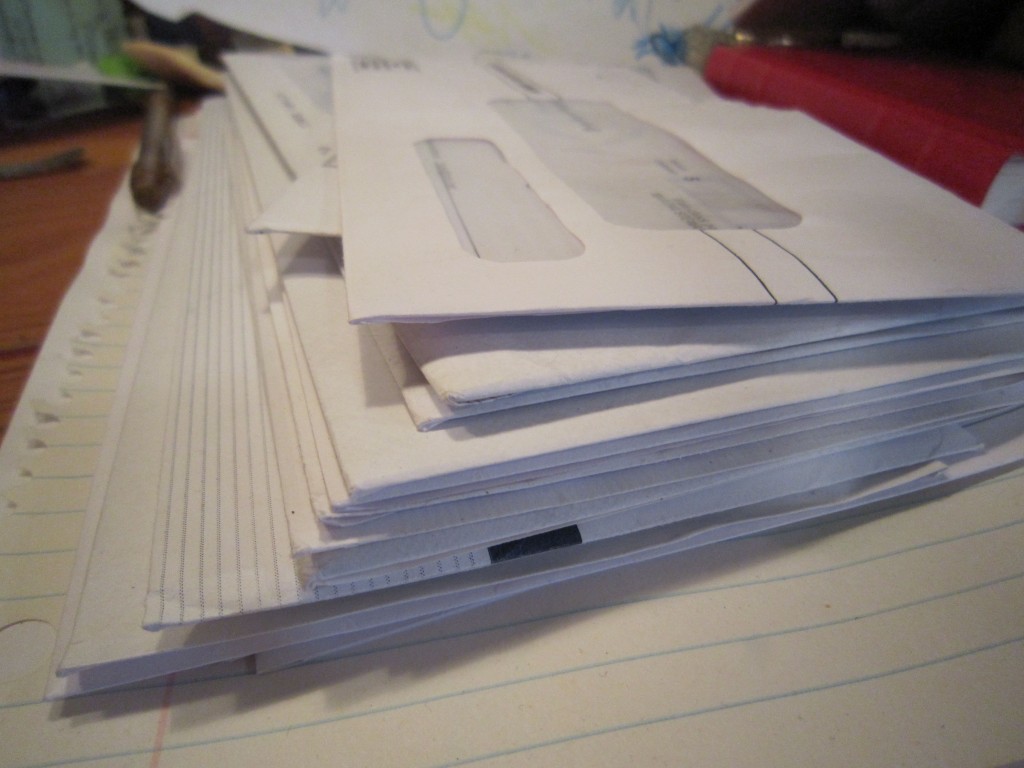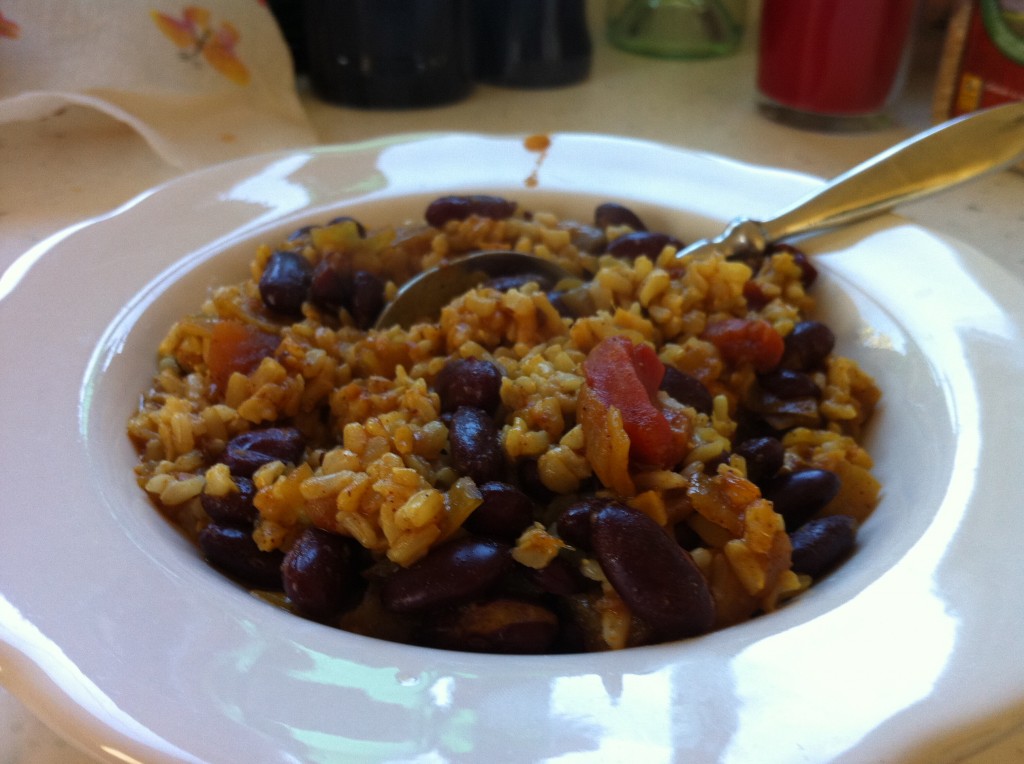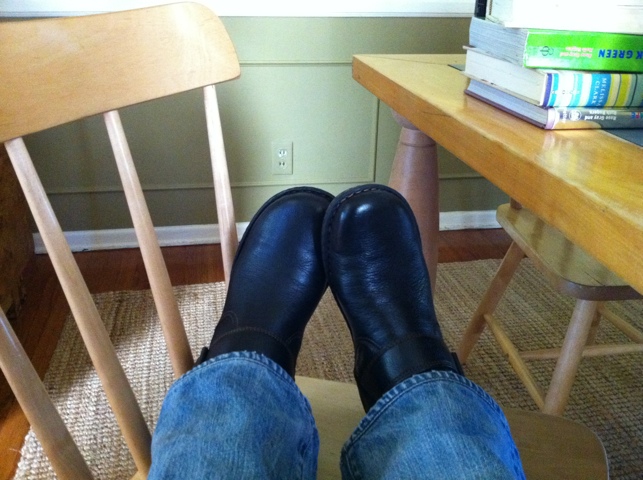 Everyone knows that the real New Year starts in February, right? January is just sort of a warm up. Maybe you brainstorm about various resolutions and plans. Maybe you just kinda get started and are working out the kinks. It’s practice. But February is for reals: you can’t say you just got back from vacation or you’re just getting over the holidays – that stuff is done. February is like 4:00 a.m. – nothing is going on. It’s just you and your whirring brain, saying, “Are you going to make this year work – or what?”
Everyone knows that the real New Year starts in February, right? January is just sort of a warm up. Maybe you brainstorm about various resolutions and plans. Maybe you just kinda get started and are working out the kinks. It’s practice. But February is for reals: you can’t say you just got back from vacation or you’re just getting over the holidays – that stuff is done. February is like 4:00 a.m. – nothing is going on. It’s just you and your whirring brain, saying, “Are you going to make this year work – or what?”
 And so it’s the perfect time to get started in earnest with the 30 Large Project. No more excuses. No monkeying around. But I’m not worried. It won’t be hard – like climbing Mount Everest or running for president. This is just being responsible. No biggie.
And so it’s the perfect time to get started in earnest with the 30 Large Project. No more excuses. No monkeying around. But I’m not worried. It won’t be hard – like climbing Mount Everest or running for president. This is just being responsible. No biggie.
 Throughout the month of February, we pledge to only spend money on “needs” (as defined by our guru Elizabeth Warren in her book, All Your Worth), such as food, gasoline, and things we are contractually required to pay, such as mortgage, cable, credit card balances, etc. We will also keep track of every penny spent, so as to begin to get a crystal clear picture of where the money goes, even when we are really thinking about it and being on our best behavior.
Throughout the month of February, we pledge to only spend money on “needs” (as defined by our guru Elizabeth Warren in her book, All Your Worth), such as food, gasoline, and things we are contractually required to pay, such as mortgage, cable, credit card balances, etc. We will also keep track of every penny spent, so as to begin to get a crystal clear picture of where the money goes, even when we are really thinking about it and being on our best behavior.
 When it comes to our (historically) monstrous food budget and my Whole Foods addiction, I expect to keep to my budget of $100 a week, not including our delicious weekly CSA box. This is going to be the tough part for me as I think a significant portion of our food – that is in excess of our $100 weekly limit – now comes from the “wants” column. Expect to see lots of cheap recipes from Nerdhaven West in February!
When it comes to our (historically) monstrous food budget and my Whole Foods addiction, I expect to keep to my budget of $100 a week, not including our delicious weekly CSA box. This is going to be the tough part for me as I think a significant portion of our food – that is in excess of our $100 weekly limit – now comes from the “wants” column. Expect to see lots of cheap recipes from Nerdhaven West in February!
 We will report back on the blog each week with a summary, describing the ups and downs and what we have done and learned. We will not publish a spreadsheet (although we have had requests to do that!) but we will try to get to the details as closely as possible so you can feel our pain . . . um, I mean responsibility . . . no – I mean our frugaliciousness.
We will report back on the blog each week with a summary, describing the ups and downs and what we have done and learned. We will not publish a spreadsheet (although we have had requests to do that!) but we will try to get to the details as closely as possible so you can feel our pain . . . um, I mean responsibility . . . no – I mean our frugaliciousness.
 P.S. Who says frugaliciousness isn’t all that photogenic? All the photos in this post are of free things around my house. And because you have made it this far in the post, I will reward you with a video of chickens arguing over string cheese. Click here: LoudMo
P.S. Who says frugaliciousness isn’t all that photogenic? All the photos in this post are of free things around my house. And because you have made it this far in the post, I will reward you with a video of chickens arguing over string cheese. Click here: LoudMo
Category Archives: 30 Large Project
Rainy day accounting
Rain. Slow, steady, glorious rain. Florida desperately needs it. I didn’t realize how much I needed it. The sound helps focus and calm me. The pervading damp gives me permission to postpone my many outdoor tasks. Rain removes the excuses that keep me from planting my rear in the chair and writing about budgeting. I’m not resistant to writing itself, just to the hard work of examining our expenditures that I must do first.
Number crunching is not my strong point. So why am I taking on the 30 Large Project? Because I want to continue to grow and learn, because what one focuses on becomes stronger, because of the platitude “ignore it and it will go away” also applies to money.
My DH may, or may not, agree, but it seems to me we spend on whatever we want, whenever we want it. Denial is not in our vocabulary. Although our income is fairly secure, it is certainly not exorbitant. Hence, I am in the early chapters of All Your Worth, preparing for the worst.
Step One of the budgeting process in Warren’s book is to figure out how much we are spending on needs, wants and savings. I have decided to focus on the needs category first, and the rest should follow from there. To do this I first had to get a handle on where all the money is going, which for us, was difficult.
After a teeth-gritting, round-one look at the household income and expenses, with a look to how much we spend on needs (shouldn’t be over 50 percent of after tax income), I have been forced to realize there is no gain (in the form of a “lifetime money plan”) without a whole bunch of pain.
“Needs” includes certain types of expenditures that I decided to group two ways. First, I listed things we have a legal obligation to pay: student loans, mortgages, basic utilities, auto and home insurance, gym membership, cell phone contract, and preschool.
And, second, I included things we need to survive: medical prescriptions, health insurance, food, transportation, life insurance and retirement plan.
Even as I type this list of what I included, I see some things shouldn’t be in there – obviously the retirement plan should be in “savings”. Clara’s school should be in “wants,” since I am not working and we could remove her if we had to for a small fee. I need to refer to the book to see where life insurance should go. Also, I have found that our gym membership contract is up and we now pay monthly — so we can move that to wants. See — I was not expressing false modesty when I wrote I wasn’t good a number crunching. I found errors before hard math was required.
After shifting these items, I totaled the cost of our needs and divided it by our after-tax income multiplied by 100. I found we spend about 63 percent of our after-tax income in the needs category. Ugh.
A quick glance at what is left over and my worst fears are realized – it seems that the remainder goes primarily toward wants. Cable television is a want, after all.
So, what to do to bring our “needs” number down? Warren is no nonsense in her advice: basically, she says, get real. She directs readers to assess the big-ticket items first, since those have the greatest impact on the bottom line. Leading me to my next assignment – slash, slash, slash. I’ll report back soon.
Take it Easy
I am writing this post while standing on a corner in Winslow, Arizona. Not really. I am trying to take Glenn Frey’s recommendation and “take it easy.” In my mind, I am right here, chillin out:
 Image by Rogie 09 via Flickr
Image by Rogie 09 via Flickr
As part of the 30 Large Project, I have decided to try to feed my family of four for $650 a month. “Whoa!” I hear from my friends, “That is hard!” I’m thinking no: climbing Mount Everest is hard. Running for President is hard. Grocery shopping is not hard.
Rather than adopting an excuse why I can’t feed my family more cheaply (like, it’s hard), I’m proceeding with the attitude that it’s easy. Why not? Food is not rocket science (which, I hear, is actually not all that hard).
Taking the easy route, I’m starting with rice and beans – it’s not like I’m going to make this cheap eating stuff work with filet mignon. I’m also starting with Indian food: flavorful, lots of veggie options (veggies being cheaper than meat), and our kids really like it. It’s probably the #1 thing they fell in love with on their trip to London a couple summers ago. No, not the Tower of London or scones or theater: Indian food was the take away . . .
So I got an Indian food cookbook, Vij’s at Home: Relax, Honey (even the title seems to take it easy). We have been to Vij’s restaurant in Vancouver, B.C., and had the greatest time, so I was happy to get the chance to try some of their food at home. Turns out, Indian food is super cheap – and can be easy to make as well. Funny, I always thought making Indian food was hard – you know, like ending global warming.
Back to rice and beans. I made their Rajmal Chawal (aka kidney beans and rice). It was delicious. We ate it for dinner (with a veggie alongside) and then we had enough for several lunches of leftovers. See? Cheap and easy.
 Kidney Beans and Rice aka Rajma Chawal
Kidney Beans and Rice aka Rajma Chawal
Adapted from Vij’s at Home: Relax, Honey by Meeru Dhalwala & Vikram Vij
The first time I made this, I made it exactly as the recipe instructed, but I thought – while it was super yummy – it was too watery and too spicy. We also really like ginger, so I added extra. I have given you my preferred measurements here. Feel free to add more cayenne (up to 1t) and more water (up to 6 cups) if you want it spicier or soupier. If you (like my sister) are not a fan of kidney beans (as a kid she meticulously removed them from her chili) you can switch out for pinto beans.
I’m not always great with getting the ingredients all ready beforehand, but it is a must with this recipe. Chop the onion, press the garlic, grate the ginger, and measure out all the spices into a small bowl before you heat the oil. It makes this recipe so much easier to put together. And easy is what we are after, after all.
½ cup canola oil
1 large onion, chopped small
2 Tbsp. chopped or pressed garlic
3 Tbsp. grated ginger
1 15 oz. can diced tomatoes
1½ Tbsp. chili powder
1 tsp. turmeric
1 Tbsp. ground cumin
1 Tbsp. ground coriander
1½ tsp. salt
¼ tsp. ground cayenne pepper
½ cup plain yogurt
4 cups water
3 14-oz. cans kidney beans, drained and rinsed
5-6 cups cooked brown basmati rice (next recipe)
Heat oil in a medium pot on medium-high for about 30 seconds. Add onion and sauté until slightly dark brown, about 8-10 minutes. Add garlic and sauté for 2 minutes, then stir in ginger and tomatoes. Add chili powder, turmeric, cumin, coriander, salt and cayenne and sauté this tomato sauce for 5-8 minutes, or “until the oil glistens on top,” as my friends Meeru and Vij say.
Put the yogurt in a small bowl. Spoon about 3 tablespoons of the hot sauce into the yogurt. Stir well, then pour the yogurt mixture into the pot of sauce. Cook for about 2 minutes.
Add water, stir and bring to a boil on high heat. Add kidney beans, stir and bring to a boil again. Reduce the heat to medium and cook for 5 minutes, or more, if you want softer beans. The recipe can be made ahead and reheated after you are done driving your daughter to theater rehearsal.
Serve over Brown Basmati Rice (next recipe) with a spinach salad or another veg on the side.
Brown Basmati Rice
Adapted from Vij’s at Home: Relax, Honey by Meeru Dhalwala & Vikram Vij
The kids used to complain about brown rice, but this stuff they love. The other day when I was cooking this rice, my daughter came home. The first words out of her mouth were, “Omigod, home smells awesome!” Really, what is better than that? You can make it without the cumin seeds and/or onion, but your daughter won’t have the same reaction.
This makes 6-8 cups rice, we always have leftovers, so we can have it with the leftover beans for lunch. When making Rajma Chawal, start the rice first because it takes longer to cook and can sit covered on the stove for awhile.
2 cups brown basmati rice
2 Tbsp. butter or canola oil
1½ tsp. cumin seeds
1 large onion, finely chopped
4 cups water
1 tsp. salt
Place rice in a medium bowl, rinse under cold water and drain. Repeat the rinsing/draining, then set rice aside.
In a large pot over medium heat, melt butter or heat oil for a minute. Add cumin seeds and sizzle for 15 seconds. Add onion and sauté until browned, about 10 minutes.
Add water and salt to the pot, then add rice and stir. Increase heat to high and bring to a boil. Immediately reduce the heat to a simmer, cover and cook for 45 minutes. When the time is up, turn off the heat and keep the lid on. The rice will steam and stay while you finish the beans and/or pick your kid up from basketball practice.
Then when you are done cooking and schlepping kids and eating – go take it easy.
Diane Breaks a Rule
Today I violated what I have long considered to be a cardinal rule: I bought cheap shoes. Boots, actually, which is even worse. Boots are an investment piece.
As long as I can remember, I have had this thing about shoes. I think it’s based on some Miss Diana Vreeland-based rule that one must wear expensive shoes and carry an expensive bag (it’s a cousin to the no white shoes after Labor Day rule).
Why Diana Vreeland’s opinion matters so much to me, I’m not certain. She was a strong, creative and outspoken woman – and I like that in a person. She wrote a classic autobiography and I like that, too. But I don’t live in Miss DV’s world. Anyway, I know that any of my “expensive” shoes would probably still seem cheap to her. It’s not like the shoes I buy are featured in Vogue (although in DV’s defense, she may have said to buy the most expensive shoes one could afford – but then she would also have been likely to be supportive of starving for fashion).
There’s definitely a part of me that understands starving for fashion’s sake. Then there’s the other part of me that gets excited about chickens and edible perennials. I think the chickens win out.
Methinks she is over-pondering the boots – but I’m thinking the cheap boots are a representation of a more mature lifestyle. Mature here means smart and responsible – not crow’s feet and a crepey neck. In the past I have justified these “investment pieces” by saying how long they will last me. For example, the last pair of boots I bought cost a few hundred dollars. But I bought them many years ago – maybe 10. I wore them a lot, they worked with pants and dresses, as work or casual-wear. They were very useful and I certainly got my money’s worth out of them. They are just too high-heeled for me these days. But what if I bought a pair of cheap – but well-made – boots and still wore them for 10 years! Then I could get even more of my money’s worth out of them. This is a revelation to me. And a few hundred dollars I can count towards saving 30 large.
Here I am, rocking my cheap – but well-made – boots:
If you are very nice, maybe in 10 years I will let you see them from the side.
Power to the People
As we begin 2012, the Occupy Wall Street protests continue across the country, Greece and the rest of the EU teeter on the brink of something precipitous, and news outlets broadcast every sigh and gasp of various global stock exchanges, I, Denise, will attempt do something nearly as life changing for our family – begin to tame the household finances. Because, while the world around me seems to be, well, (depending on whether I’m in a half-full or half-empty mood), reforming or collapsing, our household budget is one bucking bronco I can control. With will, focus, a firm grip on the rope and, above all, balance, I can and will direct this family toward debt-free prosperity.
I should say that I have not always been in this relatively privileged position. In my previous life as a single person and owner of a small business start-up, I was once so broke that I was moonlighting as a waitress and even had to borrow money from my sister to cover my mortgage one dire month. Credit card debt piled up faster than discarded wrapping paper on Christmas morning.
As a single person I could scrimp and cut costs to nothing. Eat air and water. Now, married with a family the responsibilities are different. My husband and I agree we need to plan ahead. We have the power to do this. With the Warren book, we have a sensible guide that is designed to help “the little guy” like us make our way through a frenzied financial field that is not necessarily level.
 We at NerdHaven Farms South have a few positives on our side: My husband, the breadwinner, is a tenured professor. Until the government does away with the tenure system (which could be soon), he has job security. (Buddha knows security is an illusion, but I want to help bolster any here-and-now “security” we appear to have with the application of moderation.)
We at NerdHaven Farms South have a few positives on our side: My husband, the breadwinner, is a tenured professor. Until the government does away with the tenure system (which could be soon), he has job security. (Buddha knows security is an illusion, but I want to help bolster any here-and-now “security” we appear to have with the application of moderation.)
Also in our favor is our location. North Florida has a relatively low cost of living as compared to say, Los Angeles. Our farmer’s market veggies are cheaper, our restaurants much less expensive (if also less varied and less bleeping* amazing). Entertainment costs are pennies on the dollar to LA’s.
Working against us is our age at the onset of this true experiment. My husband and I are in our 40s, leaving us precious little time to save for retirement, pay off mortgages and student loans, let alone save for our daughter’s education. Late bloomers are we, which is one reason why we have a (fabulous) three-year-old daughter, Clara, otherwise known as She-Who-Will-Have-Increasingly More-Expensive-Needs. I thought the cost of those biodegradable diapers was high – bring on the swim, ballet and gymnastic classes, etc. Phew. I can feel college looming on the horizon.
To survive it, my husband and I agree we must get our house in order now. I’m nearly finished reading All Your Worth. From it I have gleaned Warren’s plan to balance our budget. While I can’t go into specifics yet, from the book I have learned creating a budget is, contrary to what many of us have heard our entire lives, not about penny-pinching, rather it is about balance. Innocuous, powerful, central — balance. So for the next few days I’m going to crunch numbers until I can uncover how much we spend on each of Warren’s three categories: needs, wants and savings. Then I’m going to make a plan to make sure we spend no more than 50 percent of our after tax income on needs, 30 percent or less on wants, and 20 percent (which includes paying down debt) on savings. Wish me luck analyzing our budget. I will report back soon.

